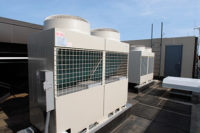RMC opened the program to HCFCs in January 2004, “demonstrating its commitment to ensuring that all surplus halocarbon refrigerants will eventually be disposed of in an environmentally acceptable manner,” Larson said.
RMC was established as an Extended Producer Responsibility Organization (EPRO) with the goal of providing an environmentally acceptable solution for the disposal of surplus ozone-depleting refrigerants. “RMC established a formal process for the collection, transportation, storage, and disposal of surplus ozone-depleting refrigerants that has been fashioned after the reclamation system in the industry,” said Larson.
Contractors bring recovered CFC and HCFC refrigerants to authorized wholesalers who in turn send the refrigerants to one of three collection service providers - Fielding Chemical Technologies, Linde Canada Inc., and Refrigerant Services Inc. They in turn send the product to destruction facilities.
The cost of the program is funded by a levy on each kilogram of HCFC refrigerant sold in Canada, currently $2.50 Canadian (or about $2.37 USD). The levy covers shipping costs from the wholesaler to the collection service provider; analysis, consolidation and storage by the collection service provider; shipping costs from the collection service provider to the destruction facility; destruction costs; and the return of empty cylinders to the wholesaler.
TRACK RECORD
• In November 2010, RMC will mark its 10th anniversary.• In 2007, RMC received the Environmental Protection Agency Best-of-the-Best Stratospheric Ozone Protection Award in recognition of its contribution to global environmental protection.
• In February 2008, RMC submitted a proposal to Environment Canada (Canada’s equivalent to the U.S. EPA) regarding the need to develop a stewardship program for HFC refrigerants.
• In May 2009, Environment Canada issued a Notice of Intent to initiate such a stewardship program. RMC said it has consulted with delegates from Norway, Columbia, Japan, Australia and the United States, regarding emulating the program.
RMC also noted that it has been granted the right to use the EcoLogo symbol, a registered trademark of Environment Canada. This distinction is granted only to products or programs that are environmentally preferable through the development and promotion of higher standards of environmental performance. The EcoLogo provides further assurance that companies have made an environmentally responsible choice when they use the RMC Program, Larson said.
An industry-led, industry-funded environmental program, RMC is a not-for-profit subsidiary of the Heating, Refrigeration and Air Conditioning Institute of Canada (HRAI).
Publication date:09/06/2010

